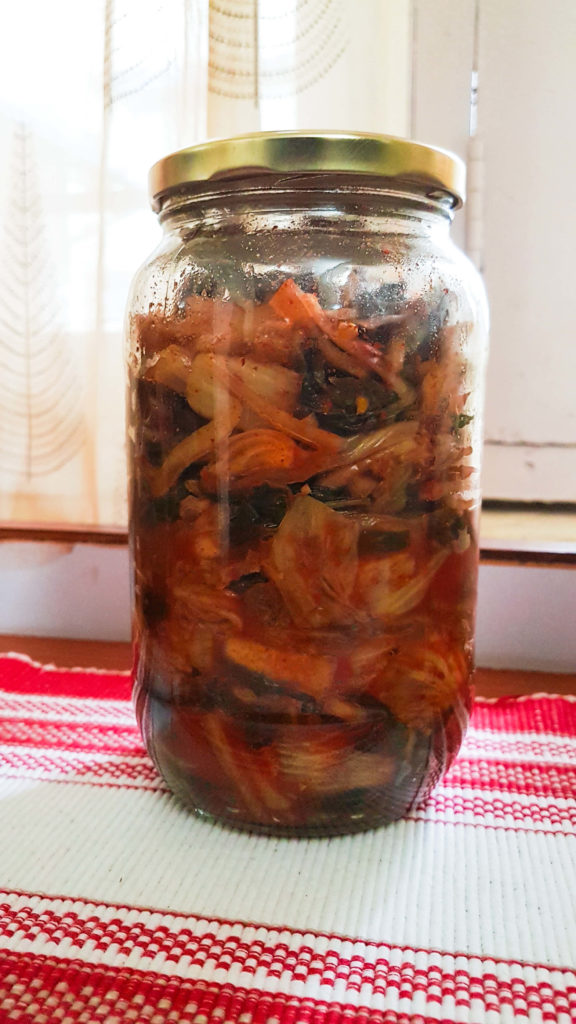Trying a traditional kimchi recipe given to me by a Korean friend was long overdue. For the 3 years that we spent living in the same city, she would drop off a generous box of kimchi ever so often. We were hooked on the stuff. So when we bade each other farewell, she bartered her kimchi recipe for kulfi and fish moily recipes from me.

Think of kimchi as a sort of fermented pickle, generally made with a Napa cabbage (also known as Chinese cabbage in India), but kimchi is also made with daikon and other kinds of radish, cucumbers, mustard leaves and many other vegetables. The kimchi flavour is complex to say the least, with some beautiful funk thrown in, which actually gives this cabbage creation its personality. It’s fermented and full of umami, a pleasant amount of heat from Korean chilli powder, gentle saltiness from preserved shrimp or fish sauce and subtle sourness from the preserving process.
This Korean kimchi recipe is for the most common variety or baechu kimchi, made with Napa cabbage, radish and green onion, (spring onions) or scallions. The kimchi-making tradition or gimjang is a time-honoured one, which happens just before the onset of winter, when large earthen vats of kimchi are buried in the ground and sealed for the magic to happen. This fermented treasure is not only delicious but healthy as well. Lactobacillus or good gut bacteria abounds in kimchi apart from all the vitamin goodness.
At home, the refrigerator serves the purpose and a jar of kimchi in the fridge means I can have kimchi pancakes (kimchijeon), kimchi fried rice or noodles in a pinch (especially when the pressure mounts to keep the school lunchbox interesting).




Now a traditional kimchi recipe does not have a long list of ingredients, but a couple of them are hard to find, especially here in India. But I trawled the internet and leafed through a few Korean kimchi recipes in cookbooks and I noticed that many of them list alternative ingredients that would work almost as well. And I guess homemade kimchi is about that – improvising, making it as close to the real thing even if it’s difficult to achieve 100% authenticity. And happily, when I open the jar of kimchi that I have at the end of this endeavour and smell the contents, it takes me back to all the delicious Korean meals we enjoyed at my friend’s. So yes, I have substituted salted shrimp sauce with fish sauce and Korean chilli powder gochugaru with a mix of sun-dried, hot chilli flakes and paprika (for colour), but the result couldn’t please me more. For a vegetarian kimchi recipe, just replace the fish sauce with a tablespoon of red miso paste. Make sure the paste coats the cabbage well and I would suggest leaving it for a few more days to ferment.

A post on how to make kimchi at home must warn you about using gloves while mixing the seasoning with the cabbage. You’ll notice in my photos that I’m not, and I was okay but if you’re unsure, please protect your hands. Also, make sure your fresh ingredients are cleaned well and that your jar is sterilised and has an airtight lid. You may notice that the process releases some gas; don’t be alarmed, just open the lid, release the gas and seal it again. Patience is also a key ingredient. Once bottled, allow the seasoning to do its stuff with the vegetables. Stash it in a cold corner of your fridge and forget about it for 15 days. Kimchi is bold and beautiful and to be enjoyed in its full glory, it must be allowed to grow its feet of flavours to stand upon. This a really easy kimchi recipe that anyone can make. My next batch will be double since I’m already halfway through this lot. Kimchi grilled cheese anyone?

Kimchi
Ingredients
- 1 2-2.5 kg Napa cabbage cut into large chunks
- 200 white radish or daikon cut into matchsticks
- 50 g scallions cut into long pieces
- 100 g sea salt
Seasoning
- 200 g Korean chilli powder gochugaru or 100 g hot chilli flakes + 100 g paprika
- 4 tbsp sugar
- 100 ml fish sauce or salted anchovy sauce or salted shrimp sauce
- 2 tbsp garlic roughly crushed
- 1 tbsp grated ginger
Instructions
- Place the chopped Napa cabbage in a large bowl or wide platter. Sprinkle the sea salt all over and toss lightly to ensure that the salt is evenly distributed throughout the cabbage.
- Cover tightly with plastic wrap and leave in a cool place (in the fridge during summer) for 7-8 hours or overnight.
- Then drain the cabbage of all the water that the salt has drawn and wash in plenty of water to wash off the salt.
- Drain the cabbage chunks thoroughly and place in a large bowl along with the radish and green onion. Add all the ingredients for seasoning and toss well to coat every piece of vegetable.
- Pack the kimchi into glass jars with tight lids and store in the fridge for 15 days to allow the curing to happen.
- After 2 weeks, the kimchi is ready to eat.

